Saint Louis University
Experimental classroom explores new ways to engage today's learners
St. Louis, Missouri, US
Download PDF (369.4 KB)
Suspecting that the way classrooms have looked and worked for decades might not be the smartest approach in the years to come, Saint Louis University has transformed one into a learning studio—a laboratory for figuring out the classroom of the future.
Room 213 in SLU’s Center for Global Citizenship is a distinct departure from the ordinary, brimming with technology and furnishings that invite new ways of teaching and learning.
“How do we best reach future generations of students?” asks Dr. Paaige Turner, associate vice president, international and academic affairs. “We think of our learning studio as a pilot classroom—a place to try out ideas that eventually can be implemented across the university.”
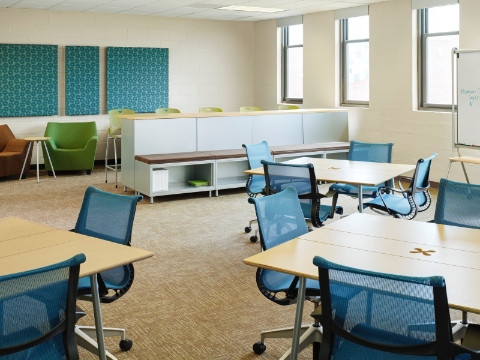
With lounge seating, stools, mobile chairs, and a bench, SLU’s learning studio recognizes that forcing students to sit in rows isn’t always best.
Learning Spaces Research Program
Saint Louis University is one of about two dozen schools that have designed learning studios through Herman Miller’s Learning Spaces Research Program, a collaborative effort between Herman Miller and participating universities.
The nature of each learning studio varies from school to school, but all are designed to support new teaching methodologies and contemporary students—those who learn best when not forced to sit in rows and raise their hands.
“Research before and after the transformation reveals how well faculty and students are adapting to the space—and which aspects might be worth integrating elsewhere on campus,” says Jeff Vredevoogd, director of Herman Miller Education. “We want to give schools a way to try new approaches on a small scale before making big decisions about learning space design.”
A Blank Canvas
SLU’s learning studio project was led by the university’s Division of Academic Affairs and the Reinert Center for Transformative Teaching and Learning, which works with faculty to foster innovative teaching practices. A team of students, staff, faculty, and consultants from both the Reinert Center and Information Technology Services conceptualized the space. Herman Miller representatives also participated, sharing best practices gleaned from experience with learning studios at other universities.
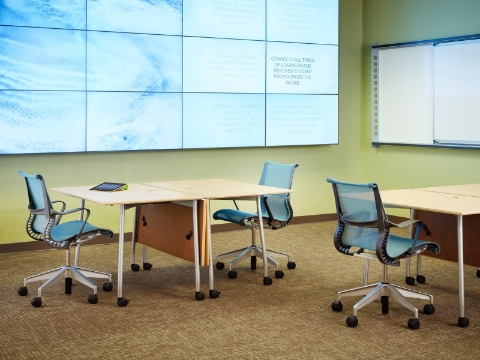
A video wall projects information from multiple sources, while mobile furnishings make the room easy to reconfigure.
Beginning with a blank canvas, the team met dozens of times to brainstorm every element of SLU’s learning studio. Once it identified key values that would shape the space, the team worked with Herman Miller to identify design attributes that could reflect those values.
“Our job was to interpret what the university wanted to accomplish and turn it into drawings, specifications, and, ultimately, a working classroom,” says designer Melissa Finley of New Paradigm Interiors, a Herman Miller dealer in St. Louis.
Saint Louis University’s vision dovetailed with Herman Miller research that suggests learning spaces need to become more flexible, collaborative, and tech savvy to reach contemporary students.
Featuring a video wall with multiple screens, the SLU learning studio allows instructors to project information from multiple sources. The room also is equipped for teleconferencing, providing a link to the school’s many international programs. What’s more, a cache of iPads and tablet computers allows faculty to transform a traditional lecture course into a multimedia experience.
“Textbooks used to be our only resource,” Dr. Turner says. “Students today live in a world with multiple points of information, so our classrooms must be able to pull from multiple sources as well.”
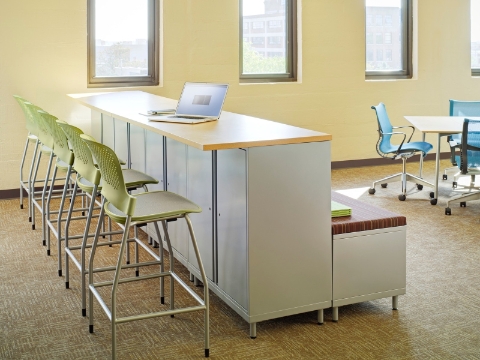
Meridian group furniture provides an elevated seating option for students and secure storage for instructors.
Quick Change
Another defining characteristic is the room’s ability to reconfigure on the fly—from lecture style to small groups to whatever it takes to advance the lesson of the moment. The central elements permitting such flexibility are a pair of Herman Miller products—Setu mesh chairs and mobile tables from the Intersect Portfolio. Intersect mobile easels also play a role, both to divide space and promote interactive learning.
“The room adapts quickly to diverse teaching methods since it isn’t stuck with an immovable layout,” says Sean O’Brien, a Herman Miller account development manager.
Instructors, untethered to the front of the room, are free to roam and give individual help. Students seem more willing to ask questions when they don’t have to speak in front of the whole class. And learning takes place from peer to peer, not just teacher to student.
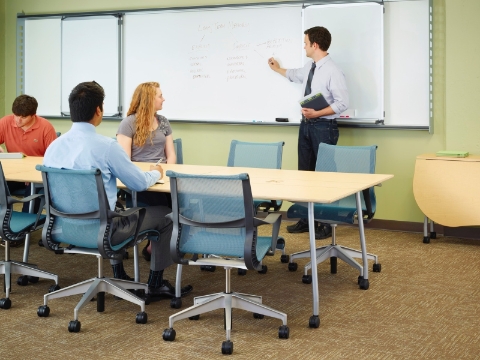
Mobile tables from the Intersect Portfolio rearrange quickly and fold out of the way when not needed.
All About Choice
The learning studio uses Swoop lounge seating to evoke the casual feel of studying at a coffee shop, and, like the other furnishings, Swoop is easily moved and arranged. The walls feature acoustical boards alongside high-tech video screens and sliding whiteboards.
At the back of the studio is a bar-height surface built from Meridian group furniture and served by a handful of Caper stools. The base consists of cabinets that lock individually, providing secure storage for each instructor who uses the room. Plans call for the elevated surface to be equipped with power ports for laptops. And the stools give students another seating option. “Today’s students want choice,” Finley explains.
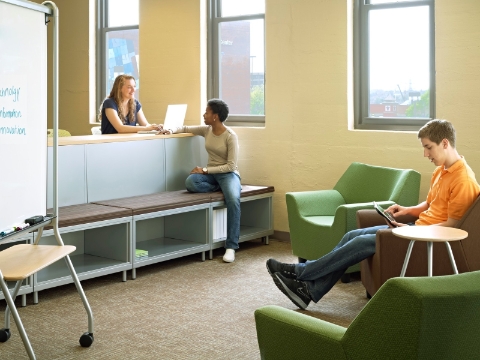
Caper stools, cushion-top Meridian storage modules, and Swoop lounge seating give students a choice about where to sit.
Low-slung, cushion-top Meridian storage modules in front of the “bar” offer students bench-style seating, as well as open compartments to stash backpacks.
So far, Saint Louis University’s learning studio is working out well. Faculty compete for fellowships to teach in the space and work closely with the Reinert Center for Transformative Teaching and Learning to redesign their course to take advantage of the creative potential.
“The reception from both faculty and students has been very positive,” Dr. Turner says. “We’re gradually learning what works best and deciding what features we’d like to implement elsewhere on campus.”
